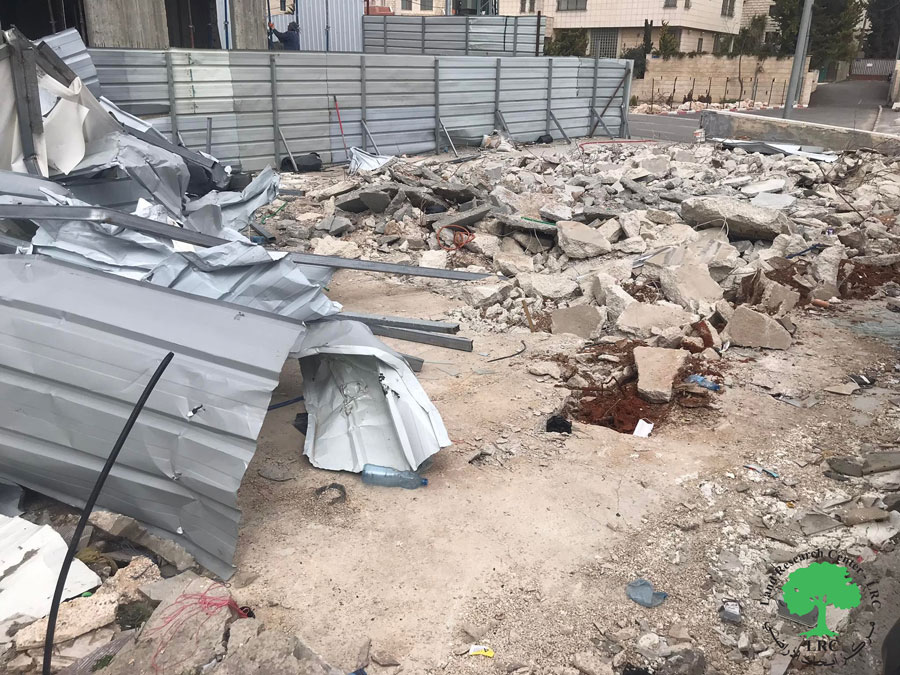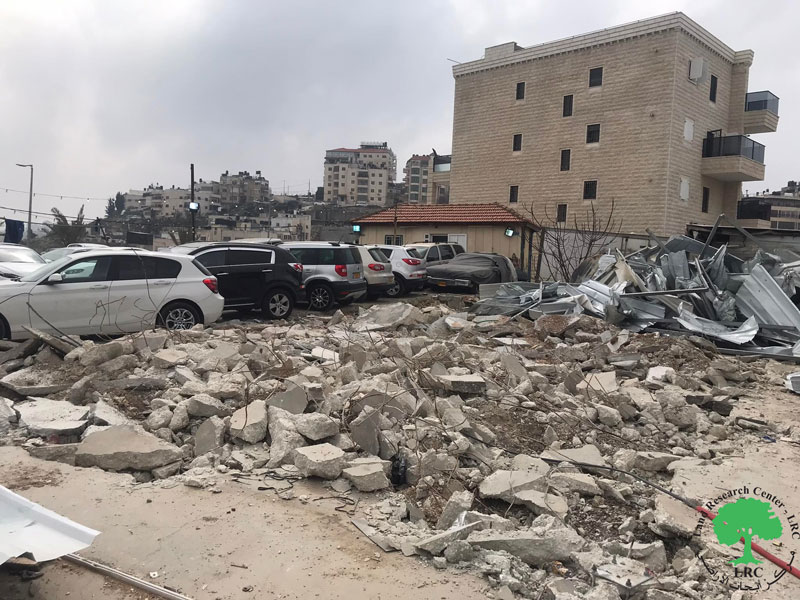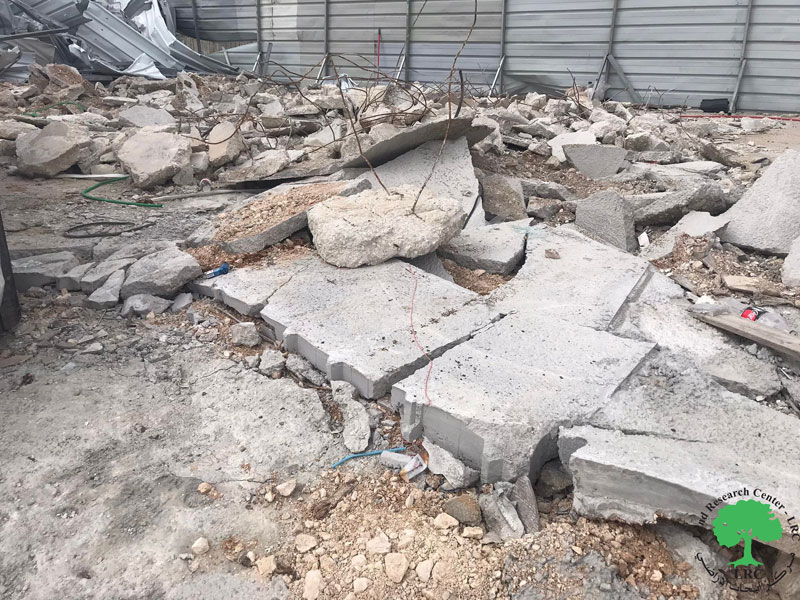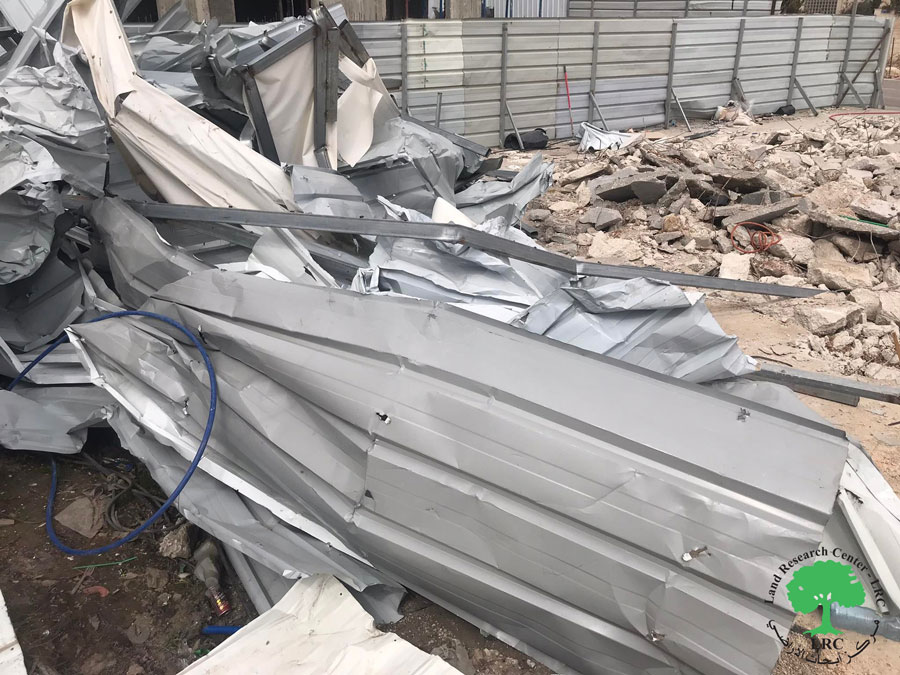2022-02-15
Demolition of a commercial facility in Beit Hanina
On the morning of February 15, 2022, the occupation municipality staff, accompanied by a military force, stormed the village of Beit Hanina, and carried out a demolition operation of a commercial facility for Mr. Ezzat Abdel Qader in the Talaat Hizma area. The owner of the facility explained that it was a car park built and used for two years, but the occupation issued a decision to demolish it without previous warning.
It is noteworthy that the facility was built in the year 2020 and provides a source of income for the family of Mr. Ezzat Abdel Qader and three of the families of his workers in the facility, and it has an area of about 100 square meters, used as a small office to manage the parking lot.
Mr. Abdul Qader expressed that in addition to the construction costs, and the sabotage of a source of income for him and his workers, he feared that the municipality would impose a heavy fine on him as a result of the demolition that was carried out in the place, in addition to that he would not be able to use the plot , at least in the nearby future.

It is noteworthy that the Palestinian village of Beit Hanina is located in the north of the city of Jerusalem on the road leading to Ramallah, eight kilometers north of central Jerusalem. The vast majority of the built-up area, and the historic Beit Hanina located outside the municipality. The total area of Beit Hanina is 16,284 dunums, and the built-up area is estimated at 2775 dunums. The occupation established several settlements, including the settlement of Atarot in the north, the settlement of Neve Ya'qub in the east, and the settlement of Ramot in the lands of the southern village. Beit Hanina is constantly exposed to Judaization which is partially represented in targeting Palestinian establishments, whether homes, farms or commercial stores in them. In addition, the process of issuing building permits costs exorbitant sums, which increases the daily suffering of the residents of the village.
About Beit Hanina:[1]
5 km north Jerusalem, Beit Hanina is surrounded by Bir Nabala (north), Beit Hanina down town (Bait Hanina town was divided to two parts by the Apartheid wall Upper Beit Hanaina and Beit Hanina down town) (west), Hizma (east) and Shufat (south). Beit Hanina has a population of 33,617 people in 2009, and an area of (8,877) , (3,341) dunums are a built up area.
The occupation confiscated over 3700 dunums for the following purposes:
Illegal colonies confiscated (3064) dunums as follows:
| colony | Establishing year | Area of confiscated lands/ dunums | Number of settlers |
| Neve Yaacov | 1972 | 575,5 | 20,250 |
| Pisgat Amir | 1985 | 684 | unavailable |
| Pisgat Zeev | 1985 | 1,458 | 38, 684 |
| Ramat Shlomo | 1990 | 346 | 12,822 |
Bypass roads (50 +60) confiscated over 482 dunums.
Apartheid wall took over 50 dunums and has a length of (987) meters.
Occupation's military camps took over (103) dunums.
Legal Commentary:
The demolition of Palestinian homes and structures by the occupation authorities is part of their violations of international and humanitarian law, and the violation of the right to adequate housing for Palestinian citizens guaranteed by international law and international treaties presented by the following articles:
The Fourth Geneva Convention, Article 147, stipulates that “extensive destruction and appropriation of property, not justified by military necessity and carried out unlawfully and wantonly” is a “grave breach” of the Convention.
Article 53 of the Fourth Geneva Convention of 1948 prohibits the destruction of property, as this article states the following: “The occupying power is prohibited from destroying any private, fixed or movable property related to individuals or groups, the state or public authorities, or social or cooperative organizations, unless the war operations inevitably require this destruction.
Article 33 of the Fourth Geneva Convention states: “No protected person may be punished for an offense he or she has not personally committed.
Paragraph ‘g’ of Article 23 of the Hague Convention of 1907 AD also warned against destroying or seizing the enemy’s property, unless the necessities of war necessarily require such destruction or seizure.
[1] GIS-LRC




